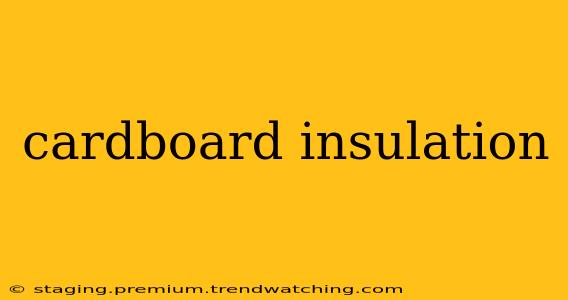Cardboard insulation is gaining traction as a sustainable and potentially cost-effective alternative to traditional insulation materials. But is it right for your project? This comprehensive guide explores the pros, cons, and applications of cardboard insulation, answering your burning questions about this eco-friendly building material.
What is Cardboard Insulation?
Cardboard insulation, also known as recycled paper insulation, is made from recycled cardboard that's been processed and treated to create a robust, insulating material. Unlike the cardboard you find in your recycling bin, this specialized product undergoes a rigorous process to enhance its fire resistance, moisture resistance, and overall insulating properties. This often involves compression and the addition of fire-retardant treatments. The result is a lightweight, easily-installable material with impressive thermal performance, depending on the specific product and its density.
Is Cardboard Insulation Effective?
The effectiveness of cardboard insulation depends heavily on its density and the specific manufacturing process. Higher-density cardboard insulation generally offers better thermal performance. While it may not match the R-value (a measure of thermal resistance) of fiberglass or spray foam in all cases, it still provides a significant level of insulation, particularly when used in conjunction with other insulation methods or in applications where high R-values aren't strictly necessary.
How Much Does Cardboard Insulation Cost?
Cardboard insulation is generally considered a more affordable option compared to traditional insulation materials like fiberglass or spray foam. The exact cost varies depending on the supplier, the quantity purchased, and the specific product features. However, its lower initial cost can make it an attractive choice for budget-conscious homeowners or builders.
What are the Advantages of Using Cardboard Insulation?
- Sustainability: Made from recycled materials, cardboard insulation reduces landfill waste and promotes a circular economy.
- Cost-Effectiveness: Generally less expensive than other insulation options.
- Ease of Installation: Often easier to install than some traditional insulation materials, making it a DIY-friendly option for smaller projects.
- Lightweight: Reduces the structural load on buildings, especially useful in renovations or older structures.
- Breathability: Some types allow for better moisture management compared to certain synthetic materials, potentially reducing the risk of mold growth.
What are the Disadvantages of Using Cardboard Insulation?
- Lower R-value (in some cases): May not provide the same level of thermal resistance as fiberglass or spray foam, especially in colder climates.
- Moisture Sensitivity: Although treated, it can still be susceptible to moisture damage if not properly installed and protected.
- Pest Infestation: There's a slightly higher risk of pest infestation compared to some other insulation types.
- Fire Resistance: While treated with fire retardants, it's still combustible and requires careful installation to meet fire codes.
- Availability: May not be as widely available as other insulation options in all regions.
Is Cardboard Insulation Safe?
Reputable manufacturers of cardboard insulation use fire-retardant treatments to make their products safe. However, it’s crucial to choose products from trusted sources that meet all relevant building codes and safety standards. Always follow the manufacturer's instructions for installation to ensure safe and effective use.
How is Cardboard Insulation Installed?
Installation methods vary depending on the specific product. Some types are designed for loose-fill applications, while others are available in batts or rolls similar to fiberglass insulation. It’s important to follow the manufacturer’s guidelines for proper installation to ensure optimal performance and to prevent moisture damage.
Where Can I Buy Cardboard Insulation?
Availability varies by region. The best place to start is by searching online for "cardboard insulation suppliers" along with your location. You can also contact local building supply stores to see if they carry this type of insulation.
Is Cardboard Insulation Suitable for All Climates?
The suitability of cardboard insulation depends on the climate and the specific R-value of the chosen product. In extremely cold climates, it might need to be complemented with other, higher-performing insulation materials to meet energy efficiency standards. In milder climates, it might be sufficient on its own, especially for applications where less insulation is needed, like attic spaces or walls that are already well insulated.
This information is for general knowledge and should not be considered professional advice. Always consult with qualified professionals before undertaking any building projects.

